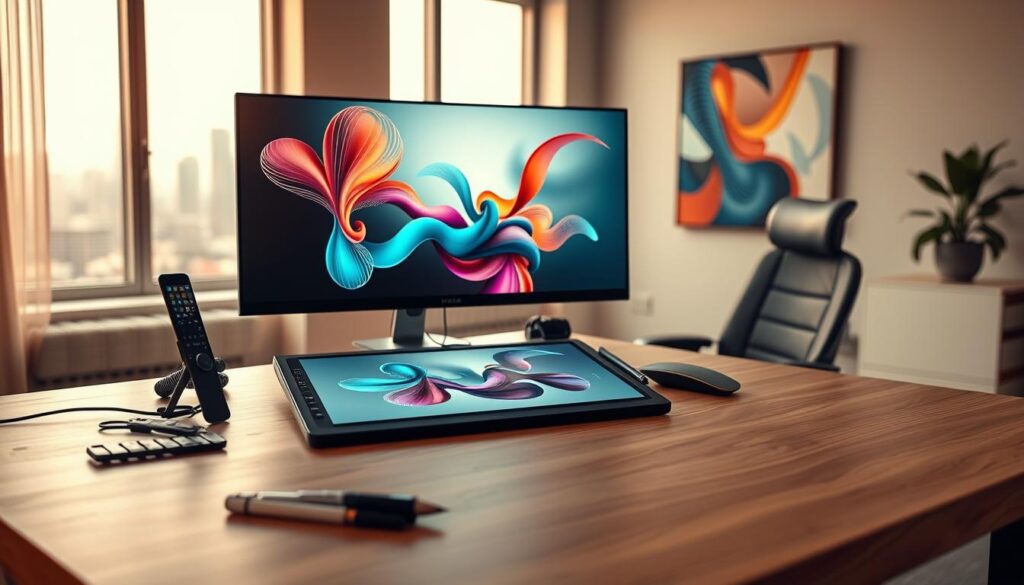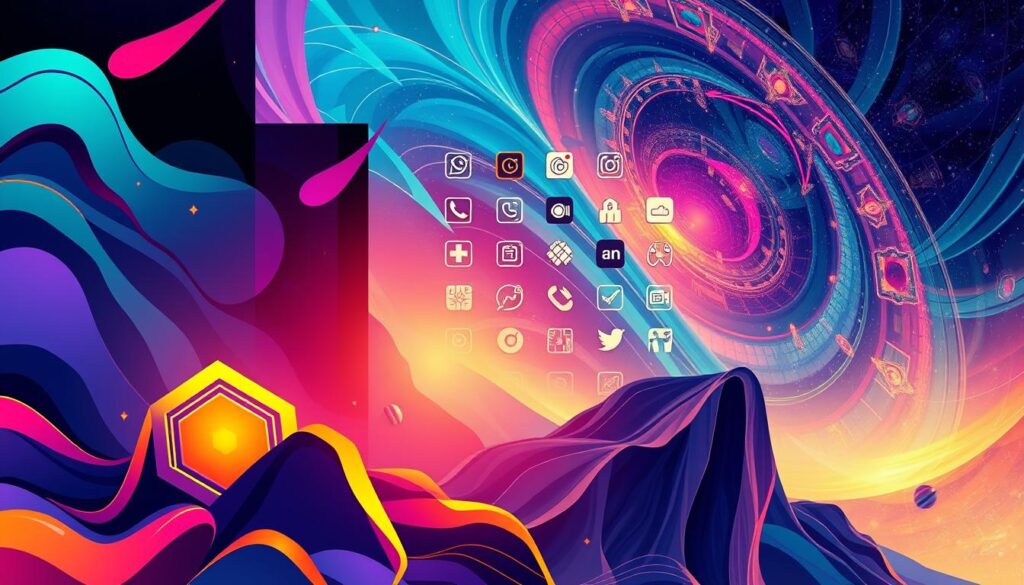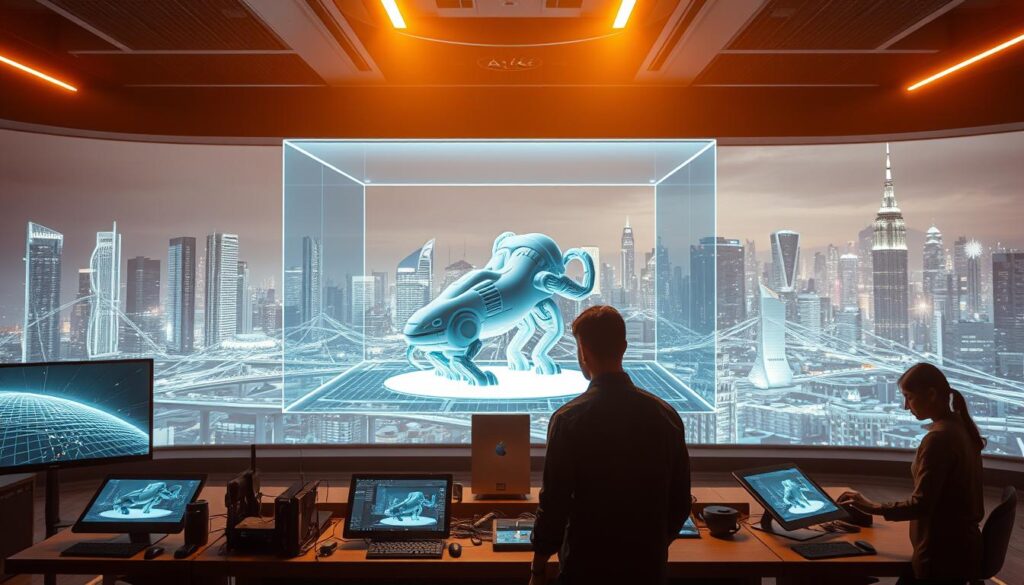“Creativity is intelligence having fun,” Albert Einstein once said. This quote perfectly captures the essence of modern design, where innovation meets efficiency. In today’s fast-paced world, the right tools can transform how we approach creative projects, making them more impactful and less time-consuming.
Designers are now leveraging advanced techniques to streamline their workflows. These methods not only enhance productivity but also improve the quality of the final output. Studies show that using specific strategies can boost creative output by up to 70%1. This approach allows professionals to focus on their unique ideas while the tools handle repetitive tasks.
One of the most significant benefits is the ability to maintain brand consistency across various platforms. This ensures that every piece of content aligns with the company’s identity, leading to better engagement and higher conversion rates2. By combining human creativity with these powerful tools, designers can achieve remarkable results.
As the demand for high-quality visuals grows, so does the need for efficient solutions. With the right approach, professionals can meet tight deadlines without compromising on quality. This balance is crucial in today’s competitive landscape.
Key Takeaways
- Specific strategies can enhance creative output by up to 70%.
- Maintaining brand consistency improves engagement and conversions.
- Efficient tools help meet tight deadlines without sacrificing quality.
- Combining human creativity with advanced methods leads to better results.
- High-quality visuals are essential for effective marketing strategies.
Introduction to AI-Powered Visual Content Design

The world of design has undergone a massive transformation in recent years. With the integration of advanced tools, professionals can now create stunning visuals in a fraction of the time. This shift has not only improved efficiency but also opened up new possibilities for creativity.
AI-powered design refers to the use of intelligent systems to automate and enhance the creative process. Over the past decade, these tools have evolved from simple templates to sophisticated platforms capable of generating unique visuals. This evolution has democratized design, making it accessible to everyone, not just trained designers3.
One of the most significant advantages is the ability to produce high-quality content quickly. For example, platforms like Canva and Adobe Firefly allow users to create graphics for social media, presentations, and more in minutes. This saves time and ensures consistency across different media channels4.
AI also plays a crucial role in interactive media. Tools like Synthesia enable the creation of multilingual videos, catering to global audiences. Similarly, generative models like DALL-E 2 and Stable Diffusion produce hyperrealistic images, pushing the boundaries of what’s possible in visual storytelling4.
Statistics show that 71% of B2B marketers consider visual content essential for their strategies3. This highlights the growing demand for efficient design solutions. By leveraging these tools, businesses can maintain brand consistency and reach wider audiences with minimal effort.
As we move forward, the role of AI in design will only continue to expand. It’s not just about automation; it’s about empowering creators to focus on their unique ideas while the tools handle the rest. This balance is key to unlocking the full potential of modern design.
Defining Design Prompts and Their Creative Impact

In the realm of modern creativity, precision meets imagination. Design prompts act as specific instructions that guide technology to produce stunning visuals. These prompts are like a cheat code, accelerating the creative process by defining style, mood, and detail5.
Today, creators rely on these prompts to push the boundaries of what’s possible. By providing clear directions, they ensure that the output aligns with their vision. This approach not only saves time but also enhances the quality of the final product6.
The Role of Technology in Visual Creativity
Technology plays a pivotal role in sparking new ideas. It helps creators explore uncharted territories, generating unique and innovative content. For instance, precise prompts can lead to hyperrealistic images or dynamic layouts that captivate audiences5.
Studies show that well-crafted instructions improve output relevance by approximately 70%5. This highlights the importance of clarity in the creative process. By leveraging these tools, creators can focus on their unique ideas while the technology handles the execution.
Practical Benefits for Creators
One of the most significant advantages is the ability to produce high-quality work quickly. For example, designers can create logos and layouts in minutes, reducing the time spent on initial concepts6. This efficiency allows them to meet tight deadlines without compromising on quality.
Another benefit is the democratization of design. With these tools, even non-designers can produce professional-grade visuals. This broadens the market landscape, making creativity accessible to everyone5.
Real-world applications demonstrate the transformative power of design prompts. From marketing campaigns to interactive media, they have revolutionized the way we approach visual storytelling. By bridging the gap between intent and technology, they empower creators to achieve remarkable results.
AI Prompts for Designing Visual Content

Crafting the perfect visual starts with clear and precise instructions. Detailed descriptions are essential for generating accurate and creative outputs. Studies show that well-crafted instructions improve output relevance by approximately 70%7. This highlights the importance of clarity in the creative process.
One effective technique is to include specific elements like image type, subject, background setting, and style. These components guide the system to produce visuals that align with your vision. For example, specifying “a minimalist logo with a modern font” ensures the output matches your brand identity7.
Balancing creative freedom with detailed instructions is crucial. Too much freedom can lead to generic results, while overly specific prompts may limit innovation. A mix of both allows for unique yet relevant visuals. This approach saves time and ensures consistency across different platforms8.
Prompt structure also impacts the composition and overall appeal of the final output. Including adjectives like “vibrant,” “serene,” or “dynamic” can influence the mood and tone of the image. This level of detail helps create visuals that resonate with your audience9.
Examples of successful prompts include “a futuristic cityscape at sunset with neon lights” or “a vintage-style poster for a coffee shop.” These instructions generate both artistic and practical designs for various media. By leveraging these tools, creators can achieve remarkable results with minimal effort.
Creative Examples: Landing Pages, Social Media, and Illustrations

Visual storytelling has become a cornerstone of modern marketing strategies. From landing pages to social media graphics, the right elements can make all the difference. These examples showcase how targeted instructions can lead to stunning results.
Stunning Landing Page Designs
Landing pages are a critical tool for driving conversions. A well-designed page can reduce the risk of visitors getting lost, increasing the likelihood of purchase finalization10. For instance, a scuba diving course uses split screens to enhance scannability and user engagement10.
Another example is a mail management service that organizes multiple communication channels, promoting productivity10. These pages often use bold typography and vibrant color palettes to create strong emotional appeals10.
Engaging Social Media Graphics
Social media thrives on eye-catching visuals. Detailed instructions can lead to graphics that resonate with audiences. For example, a fashion event uses prominent illustrations to capture attention and drive ticket sales10.
Another approach is to use testimonials and client logos to build trust immediately11. These elements, combined with a clear call-to-action, can significantly boost engagement.
Dynamic Illustrations and Infographics
Custom illustrations and animations are powerful tools for conveying messages. A kindergarten landing page incorporates playful elements to create an engaging emotional background10.
Infographics, on the other hand, use visual hierarchy to simplify complex information. For example, a cryptocurrency guide balances a business-like yet friendly mood to emphasize community engagement10.
By integrating these elements, creators can craft visuals that not only inform but also inspire. These examples demonstrate the transformative power of detailed instructions in visual storytelling.
Tips and Tricks for Crafting Effective AI Prompts

Mastering the art of crafting effective instructions can unlock endless creative possibilities. Clear and specific directions are essential for generating accurate and impactful results. Studies show that precise instructions improve output relevance by approximately 70%12.
Using Detailed Descriptions for Accurate Outputs
Detailed descriptions are the foundation of successful image generation. Include specific elements like subject, background, and style to guide the system. For example, specifying “a bustling cityscape at sunset with modern architecture” ensures the output aligns with your vision12.
Adding descriptive adjectives, such as “vibrant” or “serene,” can influence the mood and tone of the result. This level of detail helps create visuals that resonate with your audience.
Leveraging Style and Mood in Your Instructions
Style and mood play a crucial role in shaping the final output. Keywords like “watercolor style” or “dramatic lighting” can direct the system to produce more accurate representations13.
Experimenting with different phrasing, such as “bright sunny day” versus “dramatic evening light,” can yield drastically different results. This approach allows for greater customization and creativity12.
Refining instructions through iterative feedback is key. Start with a broad concept and gradually add details to achieve the desired outcome. This process ensures consistency and quality across all generated visuals13.
For more insights on crafting effective instructions, explore our comprehensive guide. These strategies will help you enhance your creative process and achieve remarkable results.
Leveraging AI Tools for Accelerated Design Workflow
Efficiency meets creativity in the modern design landscape. Advanced tools are transforming how professionals approach their work, enabling faster and more precise results. By automating repetitive tasks, these systems allow creators to focus on the bigger picture14.
Streamlining Your Design Process
One of the most significant advantages is the ability to streamline repetitive tasks. For example, generating multiple versions of a project can now be done in minutes. This not only saves time but also ensures consistency across all outputs15.
Maintaining a consistent mood and art style is crucial for brand identity. Tools like DALL-E and Stable Diffusion ensure that every piece aligns with the desired aesthetic. This level of consistency enhances brand recognition and trust16.
Rapid output generation is another key benefit. Whether it’s creating social media graphics or product mockups, these tools deliver high-quality results quickly. This efficiency is particularly valuable for teams working under tight deadlines14.
By reducing the routine workload, creators can focus on strategic decision-making. This shift allows for more innovative and impactful designs. For more insights on integrating these tools, explore our guide on graphic design techniques.
Real-world examples highlight the transformative power of these tools. From marketing campaigns to product launches, they have revolutionized the design process. By blending speed with precision, professionals can achieve remarkable results15.
Transforming Visual Content Creation for Businesses
Businesses today are redefining their marketing strategies with advanced tools. These solutions not only improve efficiency but also elevate the quality of their material. By integrating smart systems, companies can maintain a consistent brand identity across all platforms17.
Enhancing Brand Consistency
Consistency is key to building trust and recognition. Advanced tools ensure that every piece of material aligns with the company’s vision. This approach strengthens the mind of the audience, making the brand more memorable18.
For example, platforms like Canva and Adobe Firefly offer design suggestions based on past work. This ensures uniformity across all outputs, from website banners to social media posts17.
Boosting Productivity with Advanced Tools
Automation is revolutionizing how businesses operate. By handling repetitive tasks, these tools free up time for strategic decision-making. This shift not only saves time but also enhances the life of creative professionals17.
Small and medium enterprises benefit greatly from these innovations. They can now produce high-quality visuals without exceeding their budget. This democratization of design opens up new possibilities for businesses of all sizes18.
Real-world examples highlight the transformative power of these tools. From marketing campaigns to product launches, they have reshaped the range of creative possibilities. By blending speed with precision, businesses can achieve remarkable results17.
Conclusion
The future of creative workflows is being reshaped by innovative tools. These solutions empower users to produce high-quality results with precision and speed. By leveraging detailed instructions, creators can unlock endless possibilities and achieve remarkable outcomes19.
Advanced tools not only save time but also enhance consistency across projects. This ensures that every piece aligns with the desired style and mood. The ability to generate unique visuals quickly is transforming industries, from marketing to product design20.
Experimenting with image prompt techniques can lead to more engaging and impactful results. Refining these instructions allows for greater customization and creativity. This approach bridges the gap between intent and execution, delivering visuals that resonate with audiences21.
Take the next step in your creative journey. Explore these tools, refine your techniques, and discover the full potential of modern workflows. The possibilities are endless when you combine innovation with clear, detailed instructions.
FAQ
What are design prompts and how do they work?
How can AI enhance visual creativity?
What are the benefits of using AI for social media graphics?
How can businesses use AI to improve brand consistency?
What tips can improve the accuracy of AI-generated designs?
Can AI tools create dynamic illustrations and infographics?
How does AI streamline the design workflow?
What role does mood play in crafting effective prompts?
Source Links
- The Ultimate List of AI Design Prompts for the Modern Creator | Musho Blog
- Creating Visual Content with AI: The 11-Step Framework for Effective Prompting
- AI-Powered Templates: Elevating Your Visual Content Game with Minimal Effort – Venngage
- Top AI Tools for Visual Storytelling
- What Are AI Prompts in Design?
- Impact of AI Prompts on the Creative Industry
- AI Image Prompts for Eye-Catching Marketing Creatives
- 80+ AI Image Prompts for Effortless Visual Creation
- 10 ChatGPT Prompts For Visual Content Marketing
- Web Design: 26 Examples of Creative Landing Pages
- Landing Page Generator (+ AI Prompts, Examples, Best Practices)
- Writing AI Prompts: Tips & Tricks for Creatives
- 11 Tips for Optimizing AI Art Prompts to Generate Images with Deep-image.ai
- The Art of Precision: Leveraging Prompt Engineering for Superior Image Creation
- How I Actually Use AI in UX Design
- What is Prompt Engineering? An Intro to AI Prompting
- How AI is Shaping Visual Content Creation
- Text-to-Image AI: Transforming Visual Content Creation
- AI for Visual Content Creation – Bird
- The Power of Visual Communication: How AI is transforming the use of images and text together
- The Future of AI in Content Creation: Trends and Predictions







